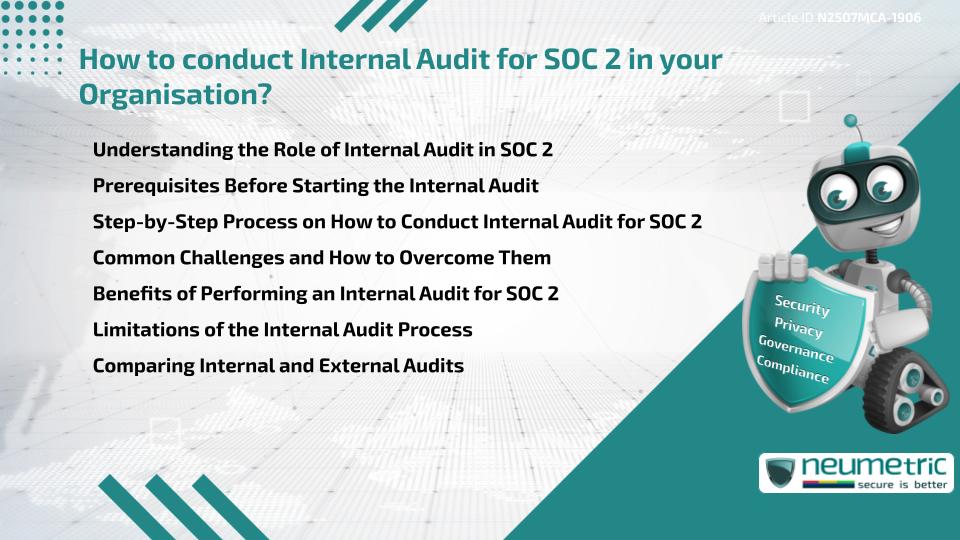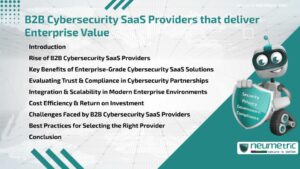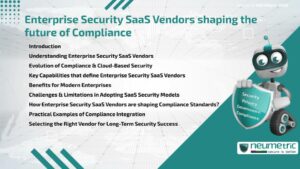Table of Contents
ToggleIntroduction
Knowing how to conduct internal audit for SOC 2 is essential for any organisation aiming to uphold trust, transparency and compliance in handling customer data. SOC 2 compliance, governed by the American Institute of Certified Public Accountants [AICPA], assesses how an organisation manages data based on five Trust Service Criteria: Security, Availability, Processing Integrity, Confidentiality and Privacy.
Internal audits serve as a proactive measure to identify and correct gaps before undergoing an external SOC 2 examination. This article will guide you through the entire process, including necessary preparations, step-by-step procedures, tools, common pitfalls and benefits of the internal audit process for SOC 2. Whether you’re new to compliance or refining your audit approach, this comprehensive guide is designed to help you stay audit-ready and confident.
Understanding the Role of Internal Audit in SOC 2
An internal audit is an independent, structured review of your organisation’s processes, policies and controls against SOC 2 requirements. It helps ensure your internal controls meet AICPA’s Trust Service Criteria.
Unlike external audits, internal audits are not about certification but about readiness. They help uncover weaknesses and create a remediation path before an official external SOC 2 audit. Think of it as a dress rehearsal before the actual performance.
For organisations aiming to reduce risk exposure and build trust with stakeholders, mastering how to conduct internal audit for SOC 2 becomes a strategic necessity.
Learn more about SOC 2 Trust Service Criteria
Prerequisites Before Starting the Internal Audit
Before you begin the audit process, ensure the following prerequisites are in place:
- Defined Scope: Clearly define which systems, teams and processes fall under the scope of SOC 2.
- Policy Framework: Establish baseline policies around information security, data handling and access controls.
- Control Mapping: Align your existing controls to the five Trust Service Criteria.
- Documentation: Maintain up-to-date documentation of processes, procedures and system configurations.
- Internal Audit Team: Assign independent personnel or teams to conduct the audit without conflicts of interest.
A lack of these foundational elements can delay your audit or lead to inaccurate findings.
Step-by-Step Process on How to Conduct Internal Audit for SOC 2
- Initiate Planning
Begin by setting audit objectives, scope and timelines. Define what success looks like and communicate expectations. - Conduct a Risk Assessment
Identify potential risks that might impact your organisation’s ability to meet the Trust Service Criteria. - Perform Gap Analysis
Compare current controls against SOC 2 requirements to identify gaps. - Evaluate Control Design and Effectiveness
Assess whether controls are appropriately designed and operating effectively. Include interviews, system reviews and sample testing. - Document Findings
Clearly record all observations, including strengths and areas needing improvement. Use consistent, factual language. - Remediation Plan
Recommend corrective actions for identified gaps. Assign responsibilities and timelines. - Follow-up Review
Conduct a follow-up to ensure remediation steps were implemented and effective. - Prepare the Audit Report
Compile all findings, assessments and remediation status into a comprehensive internal audit report.
Common Challenges and How to Overcome Them
- Lack of Role Clarity: Ensure clear responsibilities for control owners and auditors.
- Incomplete Documentation: Maintain updated and accessible records for all security controls.
- Tool Fatigue: Avoid over-reliance on multiple tools that don’t integrate well.
- Time Constraints: Plan realistic timelines and avoid audit overload by breaking tasks into phases.
Proactively addressing these challenges can lead to smoother audits and more accurate findings.
Benefits of Performing an Internal Audit for SOC 2
- Early Detection of Risks: Identifies vulnerabilities before external scrutiny.
- Process Improvement: Highlights inefficiencies and promotes operational excellence.
- Cost Savings: Reduces the risk of failing the external audit and having to repeat it.
- Stakeholder Confidence: Demonstrates proactive compliance to partners and customers.
These advantages make internal audits not just a compliance requirement but a strategic asset.
Limitations of the Internal Audit Process
While essential, internal audits have limitations:
- Lack of Full Objectivity: Internal teams may unintentionally overlook flaws.
- Scope Limitations: Often focus on high-risk areas, missing smaller issues.
- Resource Constraints: Limited budget and personnel may reduce audit depth.
It’s important to view internal audits as a complement, not a substitute, for external assessments.
Comparing Internal and External Audits
| Feature | Internal Audit | External Audit |
| Purpose | Readiness and improvement | Independent validation for compliance |
| Conducted By | Internal team or consultant | Certified third-party auditor |
| Frequency | Ongoing or scheduled internally | Annually or as per business needs |
| Cost | Lower | Higher |
| Objectivity | Moderate | High |
Both audit types serve critical roles in a robust compliance program.
Takeaways
- Internal audits are vital for SOC 2 readiness and should not be skipped.
- Ensure your organisation has documented controls, assigned responsibilities and defined scope.
- Use structured methodologies and appropriate tools to guide the audit process.
- Regular audits improve security posture and reduce audit-related stress.
- Understand the limitations and always supplement internal audits with external validation.
FAQ
What is the purpose of an internal audit for SOC 2?
An internal audit helps organisations evaluate their controls against SOC 2 requirements to identify and correct gaps before an external audit.
Who should conduct the internal audit?
Ideally, someone independent from day-to-day operations—either an internal compliance team or an external consultant—should perform the audit.
How often should internal audits be conducted?
Internal audits can be conducted annually or more frequently depending on organisational changes, growth or risk assessments.
Do internal audits replace external audits?
No, internal audits prepare your organisation for external audits but do not replace the official SOC 2 attestation.
What is included in an internal audit report?
The report typically includes the scope, control evaluation, findings, remediation actions and audit conclusions.
Can small organisations conduct SOC 2 internal audits?
Yes, even small organisations benefit from internal audits, though they may use simplified frameworks or third-party consultants.
How long does a SOC 2 internal audit take?
Depending on scope and resources, it can take anywhere from two (2) to six (6) weeks.
Need help for Security, Privacy, Governance & VAPT?
Neumetric provides organisations the necessary help to achieve their Cybersecurity, Compliance, Governance, Privacy, Certifications & Pentesting needs.
Organisations & Businesses, specifically those which provide SaaS & AI Solutions in the Fintech, BFSI & other regulated sectors, usually need a Cybersecurity Partner for meeting & maintaining the ongoing Security & Privacy needs & requirements of their Enterprise Clients & Privacy conscious Customers.
SOC 2, ISO 27001, ISO 42001, NIST, HIPAA, HECVAT, EU GDPR are some of the Frameworks that are served by Fusion – a SaaS, multimodular, multitenant, centralised, automated, Cybersecurity & Compliance Management system.
Neumetric also provides Expert Services for technical security which covers VAPT for Web Applications, APIs, iOS & Android Mobile Apps, Security Testing for AWS & other Cloud Environments & Cloud Infrastructure & other similar scopes.
Reach out to us by Email or filling out the Contact Form…





